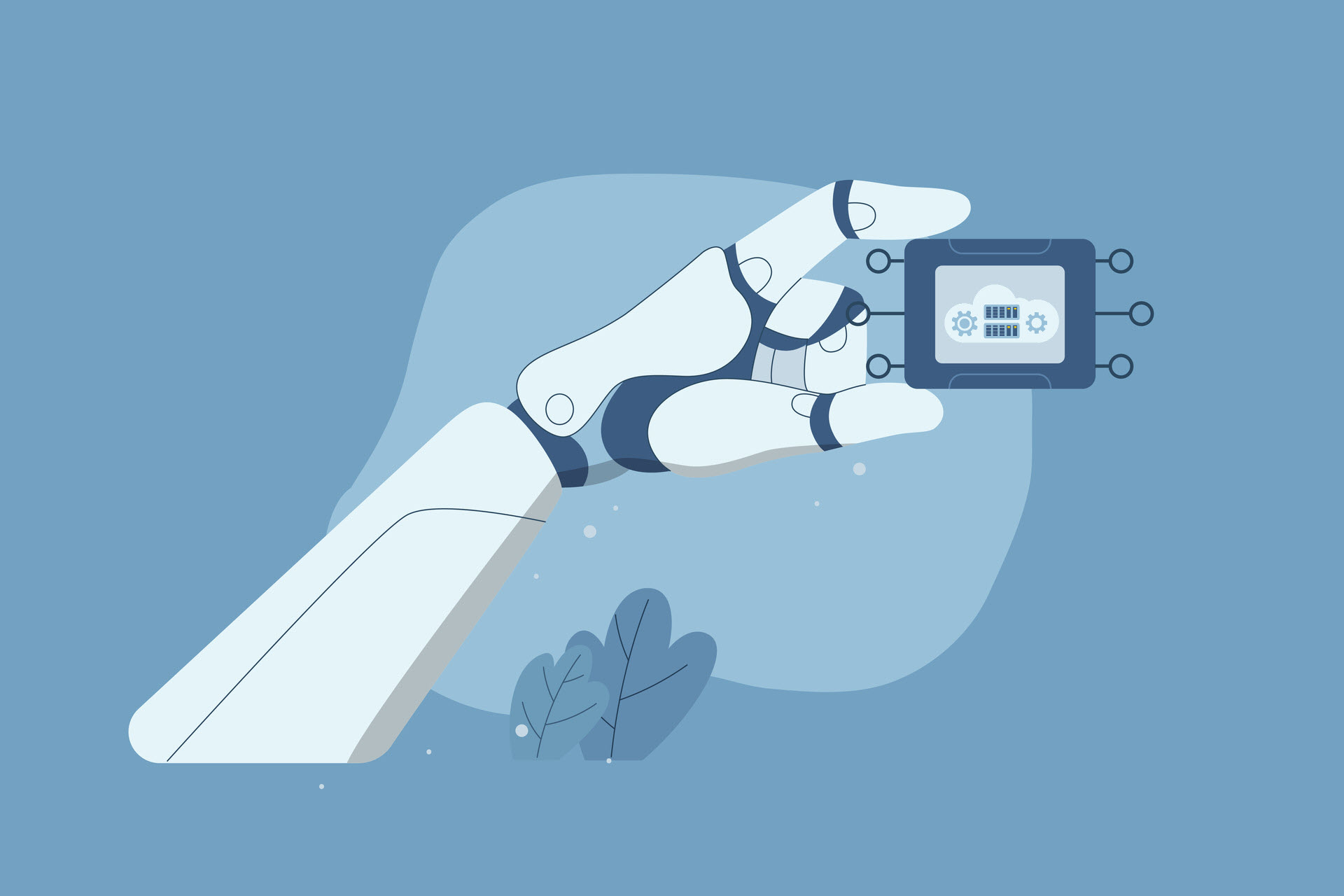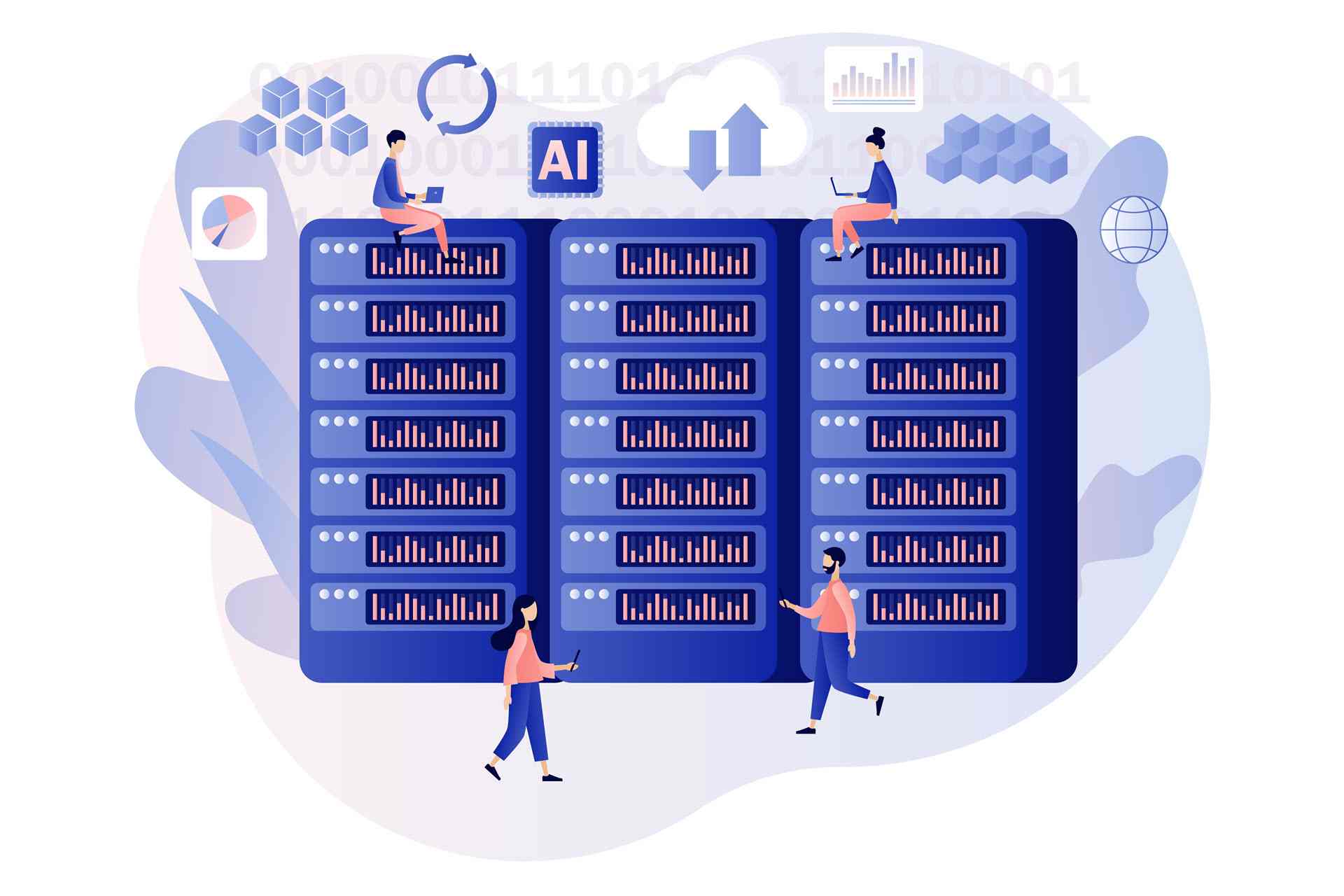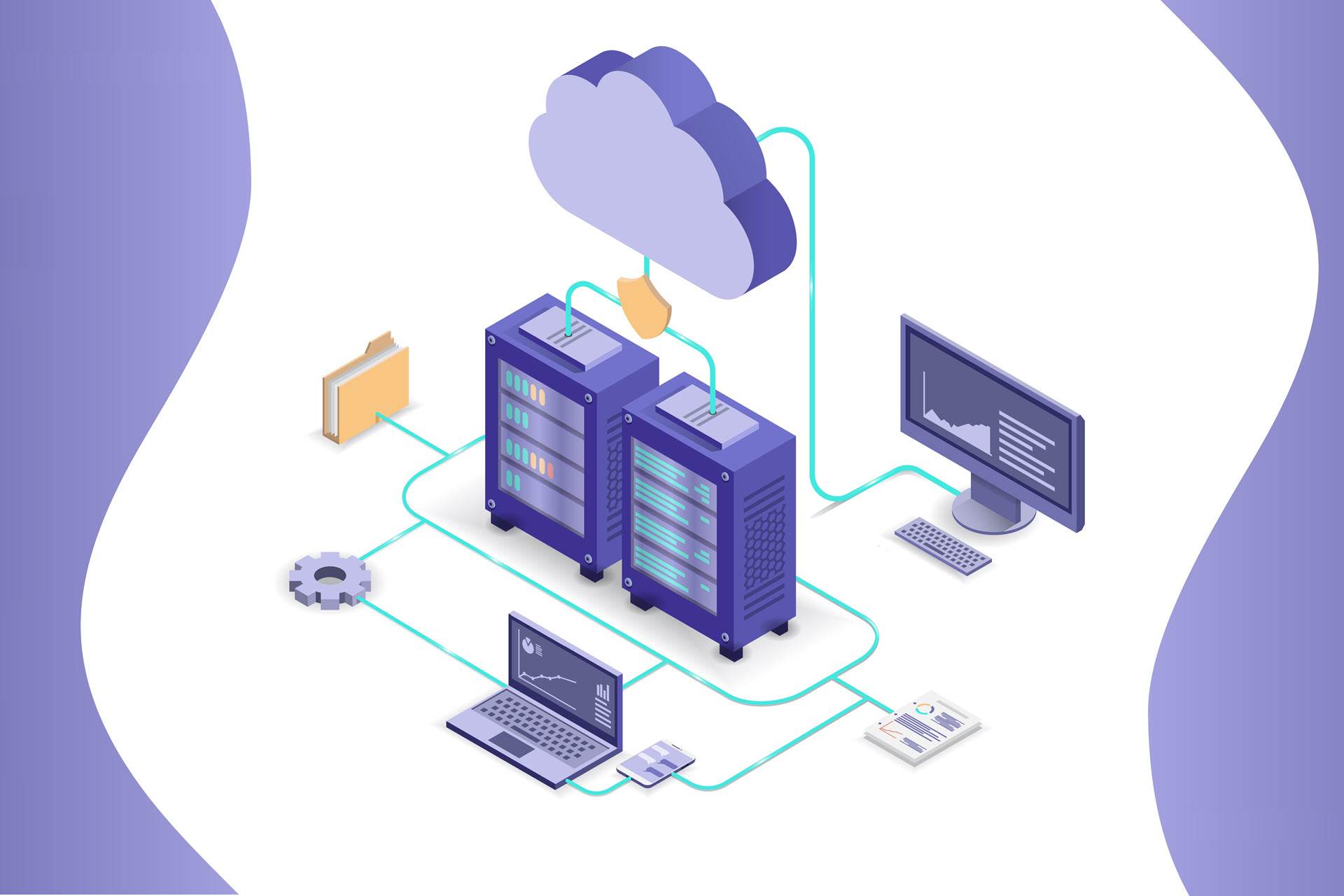The development of Artificial Intelligence (AI) and Large Language Models (LLMs) has created a demand for specialized computing environments. The primary expectation from the infrastructure powering AI is to provide sufficient GPU power and enable granular control over performance.
However, as AI workloads continue to grow, the underlying infrastructure struggles to keep pace with them. Existing systems often prove insufficient for the computational demands, creating bottlenecks. In response, a new category of cloud providers, called neocloud providers, focuses on delivering raw, scalable computing power, primarily leveraging GPUs for the most demanding workloads.
This article analyses operational characteristics, market position, and the impact of neocloud companies on AI development.

What Is a Neocloud Provider?
A neocloud provider is a cloud provider that focuses on delivering GPU-as-a-Service (GPUaaS) to meet the requirements of AI and other data-intensive applications. Specifically, these providers are built from the ground up for AI and High-Performance Computing (HPC), offering raw, scalable, GPU-produced computing power.
The following are key characteristics that define a neocloud:
- Specialized hardware. Neoclouds prioritize access to high-end, modern GPUs (e.g., Intel Data Center GPU Max 1100, NVIDIA H100s, A100s, L40s) and, where applicable, Tensor Processing Units (TPUs), coupled with high-bandwidth NVMe SSD storage. This hardware foundation is chosen for its high memory bandwidth and parallel processing capabilities, which are essential for AI workloads.
- Infrastructure transparency and control. Neoclouds offer users greater visibility and control over the underlying hardware and configuration, enabling the fine-tuning of performance. In contrast, traditional cloud environments are often hindered by layers of abstraction.
- Tailored environments. The environments provided by Neoclouds are flexible, scalable, and specifically engineered to address the performance requirements of AI, Machine Learning (ML), and similar demanding technologies. The offer frequently includes providing bare-metal or thin-VM access for near-native speed, minimizing virtualization overhead.
Prominent neocloud providers include CoreWeave, Lambda Labs, Crusoe, and Nebius.
Neocloud vs. Hyperscalers
The distinction between neoclouds and hyperscale cloud providers (e.g., Amazon Web Services, Google Cloud, Microsoft Azure) lies in their primary focus, hardware priorities, customer base, and operational models.
| Neocloud | Hyperscale Cloud | |
|---|---|---|
| Primary Focus | AI-first infrastructure and GPU workloads. | General-purpose cloud services. |
| Hardware Priority | GPU-accelerated, low-latency environments. | CPU-based, broad compute. |
| Customer Base | AI-native startups, R&D labs, ML teams. | Broad enterprise and legacy IT. |
| Configuration | Customizable, performance-optimized setups. | Predefined instance types. |
| Growth Driver | Specialized AI demand. | Scales across industries. |
| Bare-Metal or Thin-VM Access | Offered by default. | Often not offered. |
| Extra Services | Fewer but targeted. | Hundreds. |
Neoclouds serve as specialized partners in the cloud ecosystem, offering ultra-high-performance computing for AI that complements the capabilities of hyperscalers. Hyperscalers are increasingly investing in or partnering with neoclouds to address the demand for AI infrastructure. This trend indicates a shift in the market towards a multi-cloud or hybrid model.
A key differentiator for neoclouds is their access to cutting-edge GPUs. Despite global shortages and accusations of supply hoarding directed towards hyperscalers, neoclouds manage to offer fast and affordable GPU access. For example, they can deploy new hardware within weeks of new NVIDIA launches, a significant advantage over the longer lead times often seen with hyperscalers.
Neocloud vs. Traditional Cloud
The primary difference between neoclouds and traditional cloud providers lies in their architecture, where:
- Traditional clouds prioritize versatility, but struggle with modern AI workloads. Limited parallel processing capabilities and high latency in CPU-based clouds create bottlenecks because traditional clouds were not designed to meet AI-specific demands.
- Neoclouds, however, design their infrastructure with AI workloads as the foundation, creating a workload-centric model for compute-intensive applications. To achieve an AI-first design, Neocloud utilizes integrated, specialized hardware, along with smart orchestration. This approach provides dedicated clusters that reduce training time and ensure predictable performance throughout the entire AI model training lifecycle.
Neocloud Provider Features
Neocloud providers offer specialized AI workload optimization features across the entire development lifecycle. Their performance stems from a strong relationship between specialized hardware, networking, and software orchestration features.
Below are the essential features of a neocloud company:
- Flagship GPUs. Neoclouds offer on-demand access to high-end GPUs and TPUs. Their infrastructure supports high memory bandwidth and parallel processing for efficient AI model training.
- High-capacity, ultrafast storage. Neoclouds offer high-speed access for large datasets and efficient data preparation. Specialized storage solutions and dedicated resources ensure predictable performance for AI/ML pipelines.
- Low-latency networking. Network architectures prioritize low-latency, high-throughput connectivity using advanced interconnects such as InfiniBand and NVLink for direct GPU-to-GPU communication. In addition, network topologies are optimized to reduce congestion, and neoclouds extend reach to edge locations for real-time processing and distributed AI deployments.
- Container-native orchestrators. Kubernetes and other popular orchestration platforms are standard, providing consistent environments for AI jobs. Integrated AI/ML toolchains with popular frameworks reduce setup time. GPU-aware scheduling with real-time monitoring intelligently assigns workloads based on specific requirements, such as GPU utilization, memory usage, and job status.
- Enterprise-grade security. Standard security measures include encryption, innovative access management, and secure-by-design infrastructure. Additionally, neoclouds adhere to compliance certifications and employ multi-tenant isolation to separate resources and data.
- Sustainable practices. Neoclouds mitigate AI workload power consumption by applying techniques such as liquid cooling, renewable energy sourcing, and optimized workload scheduling. Some providers, for example, align with ESG goals by using waste energy to power data centers.
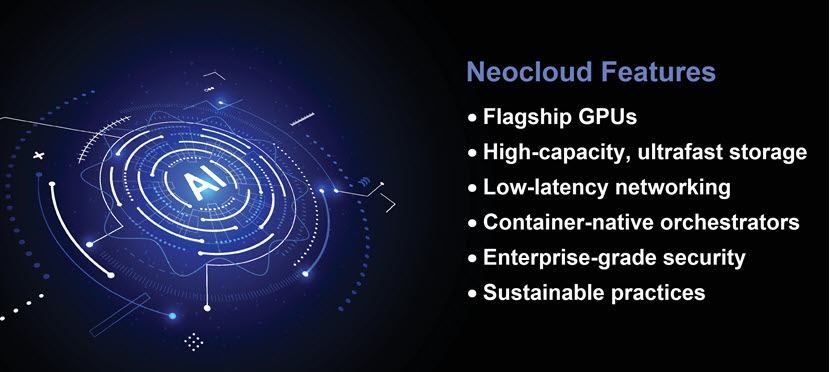
Neocloud Companies: Market Overview
Although not yet a standardized term, neocloud is an emerging category in cloud computing. The growth of this sector is linked to the broader expansion of the AI market. The global cloud AI market is valued at almost USD 90 billion in 2025, and is projected to reach USD 360 billion by 2030. Meanwhile, the GPU-as-a-Service market, a core offering of neoclouds, is projected to grow to USD 12 billion by 2030.
The following are the key factors that drive the growth:
- AI/ML demands. The fast growth of generative AI and LLMs requires infrastructure with increased GPU power and enhanced performance control.
- Edge computing. Edge AI applications and distributed cloud architectures demand regional, low-latency compute.
- Efficiency pressure. Organizations seek cost-effective and energy-efficient solutions for intensive AI workloads.
- Colocation and infrastructure partnerships. The need for specialized data center infrastructure, including advanced cooling and high power density, encourages partnerships between neoclouds and colocation providers.
How Neocloud Companies Transform AI Development
Neocloud companies are gaining a foothold in the AI development market by addressing critical infrastructure limitations and optimizing the AI workflow. A consistent emphasis on reducing DevOps overhead and faster time-to-production allows Neoclouds to abstract infrastructure complexities.
Furthermore, pre-configured environments, integrated tooling, and comprehensive observability strengthen Neocloud's position in the AI development pipeline. Neocloud enables AI development teams to focus on core model development, experimentation, and business logic rather than managing infrastructure.
The following are some of the essential ways in which neoclouds transform AI development:
- Accelerated training and inference. Neoclouds drastically reduce training times for complex AI models, often cutting timelines from weeks to hours. This acceleration is crucial for iterative model development and rapid testing. The provision of dedicated GPU and TPU clusters ensures predictable performance throughout the model training process, minimizing bottlenecks and maximizing computational efficiency.
- Streamlined AI workflows. Neocloud platforms eliminate bottlenecks associated with traditional cloud environments, such as time-consuming tool configuration, resource provisioning, dependency resolution, and managing the cost incurred by idle GPU instances. They offer out-of-the-box support for popular Machine Learning (ML) frameworks, providing pre-configured development environments, job-based billing, and integrated real-time observability.
- Democratization of advanced AI capabilities. AI startups and research labs utilize neoclouds to gain access to powerful GPUs without owning the underlying infrastructure. The immense computing power that was previously reserved for large technology giants is now available to everyone. The expanded accessibility fosters a more diverse, competitive, and innovative AI ecosystem.
Industry-Specific Benefits of Neoclouds
Beyond providing general transformative improvements to AI computing, neoclouds offer the following benefits to specific industries:
- AI startups leverage neoclouds to build innovative applications, including chatbots, search engines, and recommendation systems.
- Research labs utilize neoclouds for training large-scale machine learning models and conducting compute-intensive scientific research, including simulations and genomics.
- Media and entertainment benefit from neoclouds for real-time rendering, video processing, and visual effects production, streamlining compute-heavy workflows.
- Healthcare uses neoclouds to enable the processing of massive datasets, medical imaging analysis, real-time diagnostics, and the deployment of LLMs for applications such as radiology triage.
- Finance companies utilize neoclouds for fraud detection, anomaly processing, real-time transaction monitoring, and low-latency models for high-frequency trading strategies.
- The Automotive industry leverages neocloud capabilities to build autonomous systems that support complex simulations for self-driving vehicles, including training perception models and processing sensor datasets.
- AI-as-a-Service (AIaaS) uses neoclouds for foundational infrastructure, including custom APIs based on Convolutional Neural Networks (CNNs) or predictive analytics.
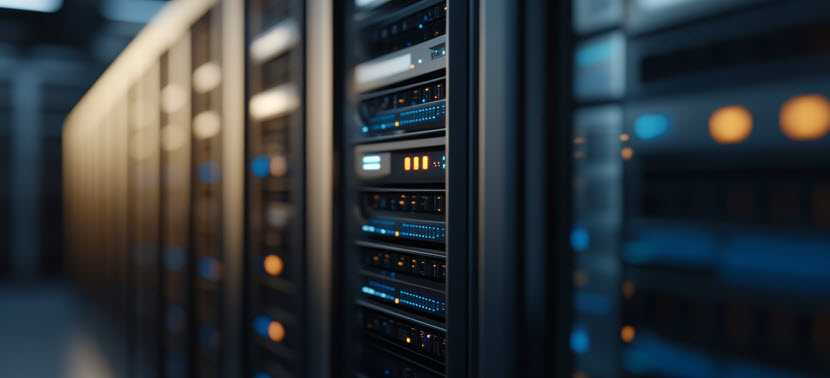
Benefits of Neocloud Companies for AI
Neocloud companies offer a set of benefits for AI development that directly address many of the challenges posed by traditional infrastructure models:
- Cost efficiency. Neoclouds offer significantly lower costs per training hour, with rates that are multiple times lower than those of hyperscalers for equivalent GPU silicon. Furthermore, the reduced DevOps overhead and simplified management imply significant operational expenditure savings in terms of personnel, maintenance, and infrastructure management.
- Predictable pricing models. Neoclouds can mitigate financial uncertainties and over-provisioning, offering a reduction in the Total Cost of Ownership (TCO) for AI infrastructure.
- Consistent compute power. Dedicated GPU and TPU clusters minimize training time and ensure predictable performance throughout the entire model training process. Moreover, direct GPU access and minimal virtualization contribute to near-native speed, maximizing the efficiency of the underlying hardware. The allocation of dedicated resources ensures consistent performance for AI/ML pipelines, eliminating noisy neighbors.
- Scalability and flexibility. Neoclouds enable dynamic resource adjustment, allowing organizations to scale their compute resources rapidly outward and inward in response to workload demands. They offer rapid elasticity, with the capability to scale from a few GPUs to thousands in minutes, without the waitlists typically associated with hyperscalers.
- Data sovereignty and compliance. Neoclouds offer greater control over the physical location of data, which is essential for compliance with regional data protection laws such as GDPR. They support sovereign AI initiatives by hosting within in-country, compliant data centers.
- Faster time to market and innovation. Neoclouds accelerate the deployment of AI platforms, significantly reducing time-to-deployment for AI projects. Consequently, they accelerate innovation cycles by eliminating infrastructure friction, allowing AI teams to focus on model development rather than operational overhead.
Challenges of Neocloud Companies in the AI Space
Despite their significant advantages, neocloud companies and their adoption face challenges and limitations within the AI ecosystem. While neoclouds' primary strength lies in their specialization and purpose-built architecture for AI, they also introduce the following vulnerabilities:
- Migration complexity. Transitioning existing AI workflows and data pipelines to a new neocloud platform can be a complex and resource-intensive process.
- Vendor lock-in. Relying on a single neocloud provider may lead to vendor lock-in, where specific services or configurations become tightly coupled, making future migration or switching to alternative providers difficult and costly.
- Hardware lock-in. The necessity of specific, high-performance GPU hardware may tie organizations to a single hardware manufacturer, introducing potential long-term risks for both support and system compatibility.
- Supply chain and geopolitical risks. Neocloud providers face challenges related to the availability and cost of GPUs and other critical components, which are highly susceptible to fluctuations in the global supply chain. Geopolitical factors, including export controls, tariffs, and semiconductor restrictions, can disrupt global chip availability and impede cross-border deployments.
- Infrastructure constraints. AI workloads demand extremely high power density (even exceeding 100 kW per rack), advanced liquid cooling systems, and high-throughput networking, which not all data centers are equipped to provide.
- High energy costs. The power-hungry nature of AI workloads necessitates continuous investment in sustainable and energy-efficient solutions.
- Operational constraints. Maintaining predictable, lossless GPU connectivity in dynamic multi-tenant environments is a significant operational challenge.
- Security and data governance concerns. The expanding attack surface, potential vulnerabilities in AI algorithms, misconfigurations, and human error all pose security risks. Therefore, implementing consistent security measures, access controls, and compliance requirements across different cloud environments requires significant effort and complex frameworks.
Neocloud Drives AI Innovation
Neocloud companies are essential for today's AI development as they provide the specialized GPU power that traditional clouds often lack. Looking ahead, their importance will only grow in the future as AI development becomes more complex. While challenges such as reliance on specific hardware exist, neoclouds continue to drive innovation, making high-performance AI accessible to everyone and accelerating the future of artificial intelligence.
